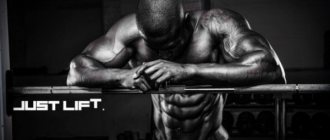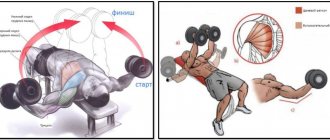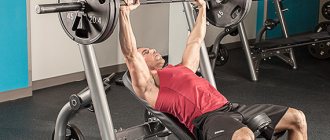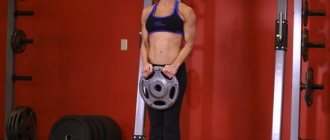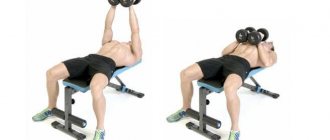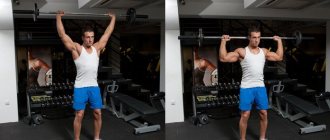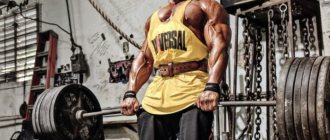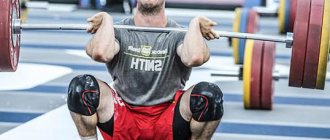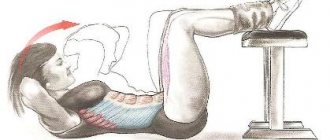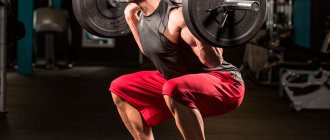What type of bench press is best for developing chest muscles? Find out what exercises you need to do to pump up your chest muscles in the gym.
Which type of bench press is best for developing chest muscles?
Is the bench press a safe exercise? Which bench press is better: flat bench, incline bench press or reverse bench press? These questions are especially important on Mondays, which many consider to be International Chest Workout Day.
Bench press
There is no exercise more discussed in the sports community than the bench press. “How long do you bench press?” - Probably everyone has heard this question.
In powerlifting, the bench press is one of the three competition movements and the only exercise that works only the upper body muscles. In bodybuilding, this can be either a great exercise for the pectoral muscles or a cause of injury.
Useful article: “How to pump up the upper pectoral muscles? Exercises and training"
Methodological and technical errors in the bench press
- Insufficient warm-up or lack thereof. This error is not specific to this exercise. This is a general requirement for all types of physical activity. A bad warm-up has disastrous consequences. At first, microtraumas that are invisible at first glance are possible. Subsequently, the situation may worsen and lead to serious problems. Moreover, a gradual approach to working weight tunes psychomotor connections for the hard work ahead.
- Changing the starting position during a motor action. Most often, the practitioner lifts his pelvis off the bench. Shortening the range of motion and overstraining the lumbar spine. Such an attempt will not be counted in competitions.
- Incorrect grip width, the definition of which was described above. As well as an open grip (thumb on top of the bar). There is a possibility of the barbell falling (slipping) from the palms. Or weak grip strength on the bar.
- Lifting the barbell from the racks using the triceps and pectoral muscles. When the bar is above the bridge of the nose, it is easiest to remove the barbell using the trapezius muscles. Bring your shoulders and collarbone forward.
- Uncontrolled descent of the projectile. It is necessary to counteract the weight of the projectile in the negative phase. The chop press is only possible with special equipment.
- Deviation from a given trajectory of movement (most often this is placing a projectile on the head). Also perform the exercise asymmetrically.
- Incorrect or neglected insurance. Insurance, like everything else, needs to be learned. There are certain rules. Therefore, the belayer is part of the process. Accordingly, he must be competent in this. This is especially true for exercises with extreme weights or repetitions.
Should I bench press?
Pressing movements are the basis of chest training. Nobody will argue with this. However, they have both advantages and a number of disadvantages.
Bench press benefits:
- The pectoral muscles and arms participate in the movement synchronously. Due to this, you can perform bench presses with more weight than when working with dumbbells.
- The bench press increases strength. When you lift heavy weights, you feel like you're getting stronger.
- Since the exercise is performed with free weights, the work of stabilizer muscles is required to control the barbell. Working in simulators does not give this. Therefore, beginners often add this exercise to their training programs.
Cons of the Bench Press:
- Your shoulders are in a dangerous position. They are pinned to the bench, so they cannot turn and assist in the movement. Due to the risk of shoulder injury, many athletes avoid this exercise.
- Failure to maintain proper bench press technique can result in a pectoral muscle tear or other serious injury. This will stop your progress.
- When no one is insuring you and you cannot press the barbell, this is another possible scenario for injury. For this reason, the dumbbell press is preferable.
It all depends on what goals you set for yourself. If you want to become stronger and bigger, then it is advisable to work with a barbell. If the possible risks are not worth it, then it is better to abandon the bench press and choose a different pressing movement for yourself.
Bench press on a horizontal bench - what muscles work
Contrary to popular belief that the barbell press is a chest exercise, this is not entirely true. If you don’t try to isolate this exercise, say, with the help of a Smith machine, then it somehow involves many other muscles.
Which muscles bear the main load:
- of course, these are the pecs - large and small, they really participate very well in the press;
- front delts and to a lesser extent middle delts;
- biceps - especially if the pecs are weak, he tries to “stretch” the exercise, since this is usually a strong muscle in everyone;
- triceps - but to use it more fully, you need to use a certain technique.
The abdominal, back and leg muscles also work very well in this case. They are stabilizers. If you really put yourself into the exercise, then after a heavy bench press you will feel the usual fatigue in your legs, as if you were pumping them separately.
The elbow and shoulder joints help in movement.
Basic exercises always involve almost all muscle groups of the body
For the exercise, a bar is used, which can also vary. Girls usually choose a lightweight straight bar (called a training bar), which weighs from 7 to 9 kg.
Men train with an Olympic bar, its weight ranges from 18 to 20 kg.
Some, if they work out at home, use a version of the training barbell, which is about 1.2 m long and weighs only 5 kg. You can understand by comparison that this is not very convenient: the Olympic bar is 2.2 m, and the barbell that girls use is about 1.8 m. But at home it is not always convenient to use a massive barbell, but you cannot press it with a wide grip you can.
Pectoral muscle training with bench press
| Exercises | Number of approaches | Number of repetitions |
| 1. Barbell bench press | 5 | 5 |
| 2. Incline Bench Press | 3 | 8 |
| 3. Dumbbell fly on a horizontal bench | 3 | 10 |
| 4. Upper chest press | 3 | 12 |
Dumbbell bench press with a narrow parallel grip
When pressing dumbbells with a narrow parallel grip, the muscles of the chest, back and triceps work.
Exercise method:
- in the starting position, the athlete lies down on the bench and presses his lower back tightly, turns his hands with the apparatus, palms facing each other, shoulder-width apart;
- while inhaling, the arms are lowered until an angle of 90° is formed with the forearm;
- As you exhale, the dumbbells are pushed out by the pectoral muscles, and the arms return to their original position.
Training the pectoral muscles without bench press
| Exercises | Number of approaches | Number of repetitions |
| 1. Incline dumbbell press (slight incline) | 3 | 8 |
| 2. Seated bench press | 3 | 8 |
| 3. Crossover crossover | 3 | 10 |
| 4. Bodyweight push-ups | 3 | To failure |
Bench Press Progression
- It is necessary to develop a stable technique for performing the bench press. Light weights should be used first. Strive to maintain the correct movement, gradually increasing the weight. An indicator of a developed technique is the execution of one repeated maximum without errors.
- Pay special attention to the lagging muscles that are involved in the movement. To do this, you need to use different variations of the press. Different grip, angle, bench press with partial amplitude.
- Work on creating stable neuromotor connections. Ideomotor training (mental, conscious representation and sensation of a motor action) will be of great help in this.
- When planning rest days (at least 72 hours), take into account that the period of mental recovery is longer than physical. Therefore, the optimal frequency of bench press training will be once every five days;
- Alternating between light and hard workouts. In this case, it is necessary to observe the undulation of the training cycle. Long enough progress in the bench press can provoke long-term stagnation. Therefore, it is necessary to deliberately reduce working weights by 10–20%. Then it is possible to increase the repeated maximum by 3–5%.
- The main part of the workout lasts no more than 40 minutes. Moreover, if this is a power load (up to three repetitions), then the rest between approaches can be up to five minutes. The number of approaches is from three to six. In strength endurance training (five to ten repetitions), pause between sets for no more than three minutes. The total number of approaches is from four to eight.
- Avoid asymmetric development of antagonist muscles. Along with presses, include traction exercises, as well as movements to develop general strength and coordination (standing press, squats with a barbell overhead).
These rules are suitable mainly for beginner and intermediate levels. Competitive athletes use a slightly different concept of the training process.
First, you need to know exactly your working weights, as well as one repetition maximum (RM). For this, there are many tables with the coefficient for calculating it. But it would be better to determine it empirically, through several training sessions. As long as you follow the correct technique.
How to choose the bench angle?
First you need to decide whether you need a bench press at all. Now let's figure out which version of the bench press you need to use to achieve specific goals.
Bench press on a horizontal bench
If this exercise worked for Arnold Schwarzenegger, it can work for you, right? During the golden era of bodybuilding, the bench press was considered the primary chest exercise. But there are some nuances here too. In the 1970s, everyone did it, but now it is considered not so effective.
If you are a powerlifter, then everything is obvious. The bench press is one of the three competition exercises. It is also used in American football to test physical performance. Athletes need to bench press a barbell weighing 100 kilograms as many times as possible. This develops strength and endurance.
For other athletes, the bench press is not as beneficial.
When performing it, it is difficult to work the pectoral muscles in isolation; There is also a high risk of injury.
Plus, it's always tempting to lift more weights to test your strength.
Useful article: “How to recover faster after an injury”
Therefore, bench presses can become an obstacle to gaining muscle mass. Luckily, you have two more options if you find that the flat bench press isn't for you.
Bench press on an incline bench
The incline press is more popular among bodybuilders because it works the upper chest more. The developed upper part gives the chest a "protruding" appearance, which Arnold showed in side poses in his heyday.
There is not a single athlete whose upper chest is too developed. Therefore, the vast majority of chest workouts are built around incline presses.
There are only two disadvantages:
- Since the angle of the bench is higher, the working weight will be less than on a horizontal bench. Some athletes do some kind of pre-fatigue: first they press a heavy weight on a horizontal bench, and then calmly work on an inclined bench.
- The movement involves the shoulders more, making it more difficult to concentrate on working the chest. Most athletes use an incline angle of 30–45 degrees. Instead, it's better to get an adjustable incline bench and place it against the racks. This will allow you to press at a lower angle. This will increase the load on the upper chest and minimize the work of the deltoid muscles. The only difficulty is that the bench and squat racks are free.
Take your starting position - lying on a bench upside down. The slope angle should be 15 - 20 degrees. If the bench has footrests, secure your feet. Hold the barbell as if you were doing a bench press, with an overhand grip slightly wider than shoulder-width apart.
- Take a breath. Lower the bar to your lower chest.
- Press the barbell perpendicular to the floor. Exhale;
Technique for performing dumbbell presses while lying on an incline bench.
This exercise develops the lower chest. It also stretches the middle part of the chest and engages the triceps, and to a lesser extent the anterior deltoids. The developed lower part of the chest emphasizes the relief and highlights the chest muscles more strongly due to its beautiful shape.
Experienced athletes have different opinions about the need to press a barbell on an incline bench . Some believe that this exercise must be included in the pectoral muscle development program, while others believe that the exercise can be included temporarily and only to add variety to the workout. We can say that everyone makes their own choice, but knowing about this exercise and its features will not be superfluous.
This differs from other pressing exercises on a flat or incline bench by the negative angle of the bench. The incline angle is not as large as with an incline bench press and does not exceed 20 degrees. If the bench has a footrest, you can tilt the bench by 20-25%. If there is no support and your feet are on the floor, then the angle of inclination will be less. If there is a large slope, the body may slide down, which should absolutely not be allowed.
Recommendations for the incline barbell press are generally similar to those for the incline barbell press. When performing this exercise, it is important that your arms move in a strictly vertical plane. Most lifters are accustomed to flat and incline presses and can control the position of their arms to prevent them from falling forward. Immediately, the arms often fall back; in this position, it is more difficult to maintain control over the barbell. Therefore, it is very important to do several warm-up sets with an empty bar or light weight to get a feel for the mechanics of the movements and prepare the muscles and joints for the load. At the lowest point, the barbell should be lowered to the bottom of the chest. If you lower it lower, to the middle or top of the chest, the muscle stretch will be very large and from this position it can be very difficult to press the barbell up, and failure may occur. This is very dangerous, as the barbell may roll onto your neck. If, as a result of failure during a classic barbell press or an incline bench press, the barbell can press on the chest and abdominal area, then when pressing a barbell on a bench with a negative incline angle, everything is much more serious.
Perform incline bench presses with a working weight only after several sets of warm-up weights. Do not increase the working weight until you are confident in your technique. Be sure to ask someone to back you up, even if you are sure that you will do the approach without anyone’s help.
Chapter:
- Chest muscles
Other chest exercises:
- Bench press
- Pushups
- Dumbbell Bench Press
- Incline Barbell Press
- Incline Dumbbell Flyes
- Incline Dumbbell Press
- Dips
- Close grip barbell press
- Cross-over
- Pull-over
How to do it: 4-5 sets of 6-15 repetitions.
The most common mistakes when doing head down presses
Most often, when performing a movement, athletes move their elbow joints away from the correct trajectory.
Moreover, this is done not only by beginners, but also by experienced athletes. This mainly occurs due to the elbows being pressed against the body, which dramatically increases the risk of joint damage. Also, sometimes athletes, after performing a head down press, very quickly and sharply rise from the bench. This cannot be done, because a large amount of blood collects in the head area, which, at the moment of rise, abruptly leaves the vessels. If an athlete has a relatively weak vascular system or there are problems with the functioning of the heart, then fainting and dizziness are possible. Don't rush to get up and do it slowly. Your body is very tired and you shouldn’t overload it with nothing to do.
Sometimes athletes push heavy weights using high-speed jerks. This has a very negative impact on the functioning of the ligamentous-articular apparatus, and also reduces the efficiency of movement. When performing the exercise, it may be advisable to use gloves to eliminate the risk of the projectile falling or at least reduce it.
Safety
The head-down barbell press is a complex exercise that requires additional physical preparation from the athlete. Without it, he is unlikely to be able to lift even a small weight. In addition, this type of press should not be performed without the help of a spotter. It will help you hold the barbell if you get too tired, and it will also help you place it correctly on the racks, since in this position it is difficult to see where to place the weight.
When working with heavy weights, it is important to pay due attention to the position of your back . Often it begins to sag and lift off the bench when the athlete tries to press up a heavy weight. There is no need to do this, as your back may get hurt at this moment. Throughout the entire exercise, it should be pressed so that the spine is always in the same position.
Also, do not forget about proper breathing . While the athlete is pulling the barbell, he should not breathe, since at this moment the muscles become as strong and tense as possible. This encourages you to perform more repetitions.
Formative exercises for chest muscles
All formative exercises are not used in the first months of training, sometimes in the first years. The initial stage of transformation of the chest muscles is aimed at increasing the volume of muscle mass; this requires basic exercises. Formative exercises are used when there is sufficient volume of the chest muscles, work in isolation is aimed at improving the form.
Presses in the Smith machine
The mechanics of the body will be the same as when performing a barbell press, but the exercise is isolated, and therefore it takes the load off the stabilizer muscles. The entire load goes to the large chest muscle.
Hand curls in the simulator
Identical to dumbbell raises, but also provides an isolated load, tension in the large chest muscle that does not extend to the small stabilizer muscles.
Work of muscles and joints
The upside down press, as noted above, loads the pectoral muscles, and primarily the lower part of the pectoral muscles. At the same time, the triceps and biceps receive the load, the latter as a stabilizer, and the triceps takes on a significant part of the load during the positive phase of the exercise. To remove the load from the triceps and, accordingly, load more of the pectoral muscles, you should move your elbows slightly down and to the sides so that at the lowest point they form an angle of 90°. It is also important to perform the exercise at a moderate pace so that you can complete 12-15 repetitions in 50 seconds.
The joints are not in the most comfortable position during this exercise, which is partly why the head down press is not recommended to be performed with heavy weight. By the way, this exercise should definitely be performed with the help of a partner who will help remove the barbell, secure it, and also put the barbell back on the rack. But it is also important to follow the technique of performing the exercise so as not to injure your elbows and shoulders. Essentially, the joints work the same as during a bench press, but they are in an awkward position, and you are lying upside down, which is why there is an active flow of blood into the head area, and this forces you to be careful!
Anatomy
The overhead press targets the strongest core of the pectoral muscles, but isolates it, so the weight should be selected with this factor in mind. In addition, since the athlete lies upside down, the exercise must be performed in the range of 12-15 repetitions, that is, with a weight at which energy is supplied through glycolysis and the formation of lactic acid. It is precisely because of the latter that there is a need to monitor breathing so carefully, since proper breathing facilitates the work of the liver. In addition, proper breathing will help reduce intracranial pressure.
From an anatomical point of view, the head down press is not the best exercise, so it should not be performed often, but only in specialized training programs. And beginners certainly shouldn’t perform this exercise in their first training programs. It should also be noted that in this exercise the shoulder joints are not in a very comfortable position, so it is better to move your elbows not to the sides, but to move them along the body as powerlifters do. To summarize, we can say that the exercise helps correct imbalances in breast development, but it should only be used by experienced athletes.
Other exercises
